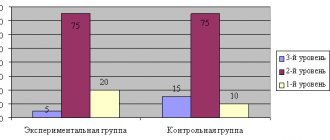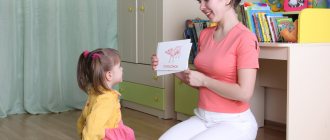The sound culture of speech is established during the period when a child learns to speak. At the age of three to seven years, children master pronunciation, intensively fill their vocabulary, discover the grammatical structure of speech, and learn to speak coherently. For each child, these processes are accompanied by unequal success. If speech disorders are not eliminated in childhood, then in subsequent years it is much more difficult to overcome them.
The concept of sound culture of speech
Speech is a complex function that involves many parts of the body. The development of speech in preschool children involves not only direct “speaking” and comprehension of what is being said. What sound production and pronunciation will be depends on how developed the speech apparatus is and how the respiratory muscles work.
Accordingly, the sound culture of speech is a multifaceted concept, including pure pronunciation, sound characteristics, speech breathing, meaningfulness of statements, and general expressiveness of speech.
Speech hearing is closely related to the work of the articulatory apparatus and respiratory muscles. Children with impaired hearing - or simply absent-minded and inattentive - find it difficult to catch and reproduce complex sounds, to ensure meaningful, expressive speech. Therefore, when talking about the education of sound culture, they necessarily include the development of speech hearing.
Didactic games
Phonemic awareness and the ability to recognize non-speech sounds can be trained using the Orchestra game. Children stand with their backs to the teacher, who makes sounds using various instruments. At first, it is advisable to give one instrument for recognition. For example, a ratchet. Then simultaneously offer 2 sounds - a rattle and a drum. Gradually increase the number of sounds. Children must say what musical instruments they heard in the orchestra.
Didactic games are suitable for differentiating sounds, in which you need to distribute given sounds into 2 groups. For example, in the game “Colorful Baskets,” the speech therapist pronounces the names of objects and phenomena, and children pick up an orange basket if they hear one sound in a word, and a yellow basket if they hear another. Similar tasks can be implemented by distributing words with the required sounds into different houses, cabinets, pots, etc.
Features of the formation of sound culture of speech of preschool children
A child’s speech is formed based on the example of verbal communication of the adults who surround him. For some parents and grandparents, it becomes a discovery that even with a baby it is inadmissible to lisp and adapt to baby talk. From the first days of life, children should hear gentle, but at the same time correct speech in terms of grammar and pronunciation. Only in this way will the development of coherent speech in preschool children occur naturally and fully.
Starting from the age of three, a preschooler will begin to repeat after adults word by word. It is extremely important that his onomatopoeia is based on distinct, correctly pronounced phrases.
Sound pronunciation
The sound aspect of speech in preschool children changes every month due to the natural improvement of the speech apparatus.
Children 3-4 years old have a characteristic speech feature that consists in softening almost all words. Most children do not yet pronounce the sound R, hissing Zh, Ch, Sh, Shch.
There is a frequent replacement of more complex sounds (so-called back-lingual) with simple (front-lingual) at the beginning of a word. Follow the movement of your tongue: it is much easier to pronounce “shuk” instead of beetle, “dolova” rather than head, “Tatya” instead of Katya.
Several consonant sounds in a row completely turn children’s phrases into new lexical inventions.
By the age of five, most children get rid of general softening. The pronunciation of words is still unstable, but almost all sounds are being mastered. Another thing is that the child does not always manage to use them appropriately. To rejoice that R, Zh and other insidious sounds have already succumbed, the preschooler uses them, replacing the quite loyal pronunciation L, T, S. For this reason, you can hear from the child “rapka” (paw), “zhuby” (teeth) and similar word creation.
Children of senior preschool age, in general, pronounce all sounds clearly, unless there are functional deviations (lisp, stuttering), the elimination of which requires special speech therapy assistance. But in six-year-olds, the rearrangement of sounds or syllables, as well as the distortion of words familiar to the immediate circle (“meat grinder”, “velisaped”) can become fixed. The reason may be either imitation, undeveloped speech hearing, or weak voluntary attention.
We recommend that you read:
- How to teach a child to pronounce the letter R.
- Speech therapy exercises for the sound L.
- Making whistling sounds.
Characteristics of speech expressiveness
The formation of sound expressiveness of speech occurs when the preschooler’s statements acquire coherence. Children grasp the melody of pronunciation of sentences before they begin to speak. Intonation, logical stress in a sentence comes when the child begins to speak meaningfully.
Elements of speech expressiveness are an important component of sound culture. Intonation and clarity of pronunciation not only add beauty to the sound. The delivery of the meaning of the message and the understanding of the content by the listener depend on them. The development of expressive speech in children can be ensured by reciting poetry and participating in theatrical performances.
Pace and speech breathing
The peculiarities of assimilation of the sound side of speech by preschoolers are also due to the fact that the child’s body has a poorly developed system of respiratory muscles and respiratory tract.
Therefore, the child may not finish words, skip complex sound combinations, and speak excessively hastily. At the same time, speech sounds excited or loud.
It is important to develop your child's breathing muscles by practicing deep inhalations and exhalations.
Exercises where you have to blow for as long as possible are useful. Blowing soap bubbles, blowing on a dandelion ball, or a competition to see who can blow a checker further on a chessboard are suitable. Such simple games develop the speech breathing of a preschooler.
Education of sound culture of speech in preschool children
What kind of speech a preschooler will have depends to a large extent on the attentive attitude of parents and educators to this issue. A culture of speech must be instilled and nurtured.
The first thing that adults need to observe is to set an example for the child with their competent speech and culture of verbal communication.
Secondly, parents are obliged to closely monitor their child’s progress in mastering their native language. What is important here is not being touched by children's pronunciation, but careful tips on how to use words correctly, an incentive to formulate a narrative sentence. It is necessary to systematically train in the pronunciation of difficult sounds in order to prevent possible speech disorders.
Formation of correct pronunciation
Parents should focus on age-related norms for the formation of pure pronunciation. Having passed the 5-year mark, the child must learn to pronounce all sounds. Already approaching this age, adults need to stimulate the development of their auditory attention as a preventive measure for possible speech problems in their child. This can be done everywhere in a playful way:
- Invite your child to close his eyes and listen to the sounds around him. Then ask what he heard.
- Practice telling fairy tales together, imitating the voices of fairy-tale characters.
- Learn to isolate sounds in a word: an adult names words, and a preschooler determines whether it contains a designated sound.
It is also easy to perform articulation gymnastics. Such tongue exercises as “Spatula”, “Needle”, “Slide”, “Clock”, “Horse” are known to everyone. These articulatory movements are simple to perform, but their effectiveness has been proven by many years of practice.
Diction and expressiveness training
The formation of diction and expressiveness is effectively promoted by memorizing and reciting small, entertaining poems. Children love funny rhyming lines. These are accessible and simple techniques for developing speech in children 3-4 years old. Kids recite poems with inspiration, trying to repeat all the accents they heard in their mother or grandmother’s recitation. Moreover, children's quatrains often include simultaneously narrative, interrogative and incentive sentences. As in this example:
In addition to training intonation expressiveness, such recitations are a fertile environment for automating sounds that are difficult for a preschooler.
Theatrical activities, which are easy to organize at home, also contribute to the development of speech expressiveness. Children love to listen to their favorite fairy tales almost every day. They know the content exactly and carefully ensure that the narrator does not miss any episodes.
It's time to assign the preschooler one of the roles that is attractive to him. Even without additional guidance, the child will try to portray the character of the hero, using the appropriate tempo and tone of speech.
Forms, methods and techniques of work on educating the sound culture of speech; article on speech development on the topic
Topic: Forms, methods and techniques of work to educate the sound culture of speech
The concept of sound culture of speech
Each language is characterized by one or another system of sounds. Therefore, the sound side of each language has its own characteristics and distinctive qualities. The sound side of the Russian language is characterized by the melodiousness of vowel sounds, the softness of the pronunciation of many consonants, and the originality of the pronunciation of each consonant sound. The emotionality and generosity of the Russian language are expressed in the richness of intonation.
Sound culture of speech - includes phonetic and orthoepic correctness of speech, its expressiveness and clear diction.
Education of sound culture involves:
1. formation of correct sound pronunciation and word pronunciation, which requires the development of speech hearing, speech breathing, and motor skills of the articulatory apparatus;
2. education of spelling-correct speech - the ability to speak according to the norms of literary pronunciation. Orthoepy includes not only pronunciation, but also stress, i.e. a specific phenomenon of oral speech.
3. formation of speech expressiveness - mastery of the means of speech expressiveness presupposes the ability to use the height and strength of the voice, the tempo and rhythm of speech, pauses, and various intonations. It has been noticed that in everyday communication the child has natural expressiveness of speech, but needs to learn voluntary, conscious expressiveness when reading poetry, retelling, and storytelling;
4. development of diction - clear, intelligible pronunciation of each sound and word separately, as well as the phrase as a whole;
5. fostering a culture of verbal communication as part of etiquette.
In the sound culture of speech, there are two sections: the culture of speech pronunciation and speech hearing. Therefore, work should be carried out in two directions:
1. development of the speech-motor apparatus (articulatory apparatus, vocal apparatus, speech breathing) and on this basis the formation of the pronunciation of sounds, words, clear articulation;
2. development of speech perception (auditory attention, speech hearing, the main components of which are phonemic hearing).
Forms of work to educate the sound culture of speech
The “Sound Culture” section of speech includes the following: developing in children attention to the sound side of audible speech, auditory memory, improving general speech skills: learning a leisurely pace of speech, correct speech breathing, maintaining the necessary rhythm when speaking, working on the voice, being able to lower and raise your voice. It is also necessary to improve the pronunciation of words that are complex in their structure, in accordance with the rules of orthoepy, observing the correct stress, and strive to clearly pronounce the sounds of the native language.
Work on the sound culture of speech also includes distinguishing by ear similar sounds, often mixed by children: S - Sh; L – R; W – F; Z – F; NW; P – B; T – D, etc., try to pronounce these sounds correctly in words, phrases, phrases, tongue twisters and poems. If such violations are permanent, you need to contact a speech therapist.
The formation of the sound side of speech is carried out in a kindergarten in two forms: in the form of training in class and outside class.
The main role in teaching belongs to special classes that combine pronunciation demonstrations with active exercise for children. Classes are complemented and interact with special exercises outside of class.
The leading form of training is collective frontal forms of work (rather than individual) classes with children. The team is a strong factor of mutual influence for children. In group activities, work productivity increases and fatigue decreases.
It is enough to conduct group-wide classes on teaching sound pronunciation 1-2 times a month. In addition, individual exercises are included in other classes on speech development, as well as in music, gymnastics and outdoor games. The number of classes is determined by the level of children's speech development.
Weekly (1-2 times a week) work in speech classes, taking from 2 to 10 minutes. Once a month, you can conduct a comprehensive lesson entirely devoted to the sound culture of speech. Such classes are especially needed in the second junior group, where the amount of work on sound pronunciation is very large. Most of the time in such a lesson is devoted to working on the pronunciation of one sound or a group of related sounds (in the older group - differentiation of pairs of sounds that are similar in acoustic characteristics: z - zh, s - s', etc.) The rest of the time is devoted to cultivating other qualities of speech (two -three).
Other forms of frontal work that are carried out outside of class are of great importance: dramatization games, round dances, holidays and entertainment. In junior and middle groups, speech gymnastics is effective (1-2 minutes of articulation exercises at the end of morning exercises, 2-3 times a week).
It is also widely practiced to work with subgroups of children at a time convenient for the teacher (didactic games, jokes, etc.). Thus, the calendar plan provides for work on the sound culture of speech almost every day.
All age-related pronunciation errors disappear in children by the age of 5. But this process does not occur on its own, but under the influence of the speech of adults and their pedagogical influence. This influence is beneficial when a child hears normal speech, receives instructions from adults on how to speak, and as a result begins to experience an interest in correct, clear speech.
During classes, during walks, during routine processes, it is necessary to very carefully monitor the children’s speech and ensure that it is clear, precise and intelligible. In the formation of correct sound pronunciation, timely training, based on the age characteristics of children, plays a decisive role.
The greatest effect is achieved by training that began at earlier stages of preschool childhood. The age of children at the start of training is a more important factor than the duration of training itself.
Methods and techniques for developing correct sound pronunciation
What methods are typical for educating the sound culture of speech?
The work is carried out using didactic games, game exercises with the inclusion of speech material: tongue twisters, sayings, nursery rhymes, poems, proverbs, riddles, stories in accordance with the program content in the native language. It is good to use speech with movement in this work. Such exercises activate the process of developing pronunciation skills.
It is advisable to introduce preschoolers to the sounds of speech in a playful way, associating each sound with a specific symbol (“Z” is the song of a mosquito, “R” is the operation of an airplane engine, “Sh” is air coming out of a burst balloon).
Such aids help to effectively prepare children with speech development problems to master writing and reading.
Games developed with symbols in which sounds are automated and differentiated are useful for children. In addition, visual symbols develop memory, attention, and imagination.
Didactic stories that include educational tasks for children are very useful (repeat words with difficult sounds, change the pitch of the voice, etc.). In junior and middle groups, they are often accompanied by a display of pictures on a flannelograph or a demonstration of toys. On the teacher’s table, you can use toys to stage a performance, during which the educational material is repeated (sound combinations, simple sayings, songs).
To develop the expressiveness of speech, classes in retelling and memorizing poems are effective. Individual elements of intonation (prosodemes), speech hearing and breathing are also practiced using the method of exercises: memorizing and repeating familiar tongue twisters, the game exercise “Let’s blow on the fluff”, etc.
Using these methods, the teacher uses a variety of techniques that directly affect the pronunciation side of children’s speech.
The leading technique is the example of correct pronunciation and task completion given by the teacher. If a teacher uses a model at the initial stage of teaching, then he often reinforces this technique with a brief or detailed explanation of the demonstrated qualities of speech or movements of the speech-motor apparatus (“You, children, hear that I don’t just say a word with the sound r, but I specifically highlight this sound, I pronounce it long, drawn out: a-r-r-r-buzz..."). When developing phonemic hearing, sound and word pronunciation, a specific technique is recommended - exaggerated (with emphasized diction) pronunciation or intonation of a sound (a stressed syllable, a part of a word distorted by children).
In younger groups, figurative naming of a sound or sound combination is often used (zzz - a mosquito song; tup-tup-tup - a kid stomps).
The demonstration and explanation of articulation in these groups is often included in the game plot (“The Tale of the Merry Tongue”). An active technique is choral and individual repetitions. They are the ones who provide training for children’s speech-motor apparatus, which is so important in the formation of the sound culture of speech. Quiet pronunciation of sounds (sound combinations) in small subgroups is especially useful, when children can listen to the answers of their comrades.
A technique such as justifying the need to complete the teacher’s assignment improves the quality of answers. It is given either in an emotional and humorous form (“Let’s teach the turkey to sing a funny song!”), or in a businesslike form (“We must firmly, firmly remember how to pronounce the word shofe-e-er, chauffeurs, otherwise speaking is simply illiterate, ugly - who wants to get into a funny situation?”).
Related to this is another technique - individual motivation for the task, an individual instruction before the child’s answer (“It seems to me that Seryozha’s lullaby will work especially well - he knows how to be affectionate and caring”).
In case of erroneous answers, such active techniques based on imitation as joint (conjugate) speech of the child and the teacher, as well as reflected speech (immediate repetition by the child of a sample speech) are possible.
In the process of practicing and consolidating a child’s pronunciation skills, an example of the correct speech of his peers is valuable. This factor should be used not only in classes, but also in freely organized games and exercises, in which both children who have not mastered some skill and those who speak correctly and clearly are involved.
Traditional techniques include evaluating a response or action and correcting it. Teachers should be warned against the annoying, too frequent use of corrections and hints (sound pronunciation, tempo, etc.), as this irritates the child. During classes, such a specific technique can be used - a figurative physical education pause, which, thanks to the combination of children’s movements with the utterance of practiced sounds or sound combinations (game situation), serves at the same time as relaxation and consolidation of educational material (leave from the tables, walk around, sit down and show like chickens clucking).
In the process of working on the sound culture of speech, visual techniques are also appropriate - showing articulatory movements, demonstrating a toy or picture. Games and exercises often involve additional equipment - a “magic” wand to signal the beginning or end of an answer, chips and other handouts that serve to indicate the sound structure of a word
Methods and techniques for developing phonemic hearing Speech hearing is a broad concept. It includes the ability for auditory attention and understanding of words, the ability to perceive and distinguish different qualities of speech: timbre (find out by voice who called you?), expressiveness (listen and guess whether the bear was scared or happy?). Developed speech hearing also includes good phonemic hearing, i.e. the ability to differentiate all the sounds (phonemes) of the native language - to distinguish the meaning of words that sound similar (duck - fishing rod, house - smoke). Speech hearing begins to develop early. A child aged two to three weeks has a selective reaction to speech and voice; at 5-6 months he reacts to intonation, and somewhat later - to the rhythm of speech; By about two years, the baby can already hear and distinguish all the sounds of his native language. We can assume that by the age of two, a child has developed phonemic hearing, although at this time there is still a gap between the assimilation of sounds by ear and their pronunciation. Having phonemic awareness is sufficient for practical speech communication, but this is not enough for mastering reading and writing. When mastering literacy, a child must develop a new, higher level of phonemic awareness - sound analysis or phonemic perception: the ability to determine which sounds are heard in a word, determine their order and quantity. This is a very complex skill, it involves the ability to listen attentively to speech, to keep in memory the word heard, the sound named. Work on the formation of speech hearing is carried out in all age groups. A large place is occupied by didactic games for the development of auditory attention, i.e. the ability to hear a sound and relate it to the source and place of presentation. In younger groups, games conducted during speech classes use musical instruments and voiced toys so that children learn to distinguish the strength and nature of sound. Simulating thunder; in the game "Guess what to do?" When the sounds of a tambourine or rattle are loud, children wave flags; when sounds are weak, they lower the flags to their knees. Widespread games are “Where did they call?”, “Guess what they are playing on?”, “What is Parsley doing behind the screen? In older groups, children’s auditory perceptions are developed not only through games similar to those described above, but also by listening to radio broadcasts, tape recordings, etc. Short-term “minutes of silence” should be practiced more often, turning them into “Who can hear more?” exercises. , “What is the room talking about?” As these exercises progress, you can ask individual children to use onomatopoeia to reproduce what they heard (water dripping from a tap, a squirrel wheel whirring, etc.). Another category consists of games for the development of speech hearing itself (for the perception and awareness of speech sounds and words). Games are offered for each age group (lasting 3-7 minutes), which are preferably played with children 1-2 times a week in and outside of class. Already in the younger group, children are asked to listen attentively to the sound of speech, distinguish its various qualities by ear, and “guess” them (the word is spoken in a whisper or loudly, slowly or quickly). So, for example, the game “Guess what I said?” encourages the child to listen attentively to the speech of the teacher and peers. This is facilitated by the game rule, which the teacher says: “I will speak quietly, you listen carefully and guess what I said. Whoever I call will say loudly and clearly that he heard.” The content of the game can be made more rich if you include in it for guessing material that is difficult for children, for example, in the middle group - words with hissing and sonorant sounds, in the older group - polysyllabic words or words that are difficult in orthoepic terms, close to each other in sound (juice -suk), as well as sounds. Middle age is the time to improve auditory perception and phonemic hearing. This is a kind of preparation of the child for the subsequent mastery of sound analysis of words. In a number of games that are played in this age group, the task is of increased complexity - from the words called by the teacher, by ear, select those that have a given sound (for example, z - the song of a mosquito), marking them with a clap of your hands, a chip. Auditory perception facilitates the slow pronunciation of a word or the prolonged pronunciation of a sound in a word. In older groups, naturally, they continue to improve their speech hearing; children learn to identify and identify various components of speech (intonation, pitch and strength of voice, etc.). But the main, most serious task is to bring the child to an awareness of the sound structure of a word and the verbal composition of a sentence. The teacher teaches children to understand the terms “word”, “sound”, “syllable” (or part of a word), to establish the sequence of sounds and syllables in a word. This work is combined with the cultivation of interest and curiosity in words and speech in general. It includes the child’s independent creative work with words, requiring verbal and poetic hearing: coming up with words with a given sound or with a given number of syllables that are similar in sound (gun - fly - drying), finishing or coming up with a rhyming word in poetic lines. In older groups, during exercises and games, children are first introduced to highlighting sentences in speech, as well as words in sentences. They compose sentences, finish words to familiar poetic lines, correctly arrange scattered words into one complete phrase, etc. Then they begin to soundly analyze the word. Exercises and games for this purpose can be arranged approximately in the following sequence: 1. “Let’s remember different words, look for similar words” (in meaning and sound: bird - titmouse - singer - small). 2. “There are sounds in a word, they come one after another. Let’s come up with words with certain sounds.” 3. “A word has parts - syllables, they, like sounds, follow one after another, but sound differently (stress). What parts does the given word consist of?” Often such exercises are of a playful nature (jump rope as many times as there are sounds in the named word; find and put into a “wonderful bag” a toy in the name of which the second sound is u (doll, Pinocchio); “buy in a store” a toy, name which begins with the sound m). Thus, in the process of learning the sound analysis of a word, speech for the first time becomes an object of study for the child, an object of awareness.
Methods and techniques for developing speech breathing
Non-speech breathing is characterized by the fact that the exhalation is equal in duration to the inhalation, they follow rhythmically one after another; in one go, all the air from the lungs is exhaled, inhalation is done through the nose, the glottis is open. When we speak, we inhale during pauses through the mouth and nose, and then exhale gradually in separate bursts, sparingly. Inhalation is performed relatively quickly, it is much shorter than exhalation. The best type of speech breathing is diaphragmatic-lower costal breathing (when inhaling, the diaphragm lowers, the lower ribs move to the sides, but the shoulders do not rise). Correct speech breathing ensures sound and voice formation and good voice sounding. Timely inhalation and long exhalation are necessary for the smooth sound of speech. The teacher’s task is to teach the child to breathe correctly during speech and to eliminate age-related deficiencies in speech breathing. First of all, children need to develop a silent, calm breath without raising their shoulders. The duration of exhalation should correspond to the age of the child: for a two- to three-year-old child, the exhalation ensures the pronunciation of a phrase of 2-3 words, for a child of middle and senior preschool age - a phrase of three to five words. Gradually, children become accustomed to exhaling more forcefully. At the same time, you need to ensure that the child has the correct posture so that tension or fatigue does not occur. To work on speech breathing, some gymnastic exercises are used (“Wood splitter”, “Pump”), as well as game exercises (blowing paper birds, balls, etc.). Of great importance is the correct, detailed explanation by the teacher of the breathing requirements of children, reproducing the pattern of inhalation and exhalation. Thus, the work of educating the sound culture of speech is a whole system carried out from the first days of a child’s stay in kindergarten. Without the special attention of adults, the development of the sound side of children's speech is delayed, and negative speech habits may develop that are very difficult to overcome.




